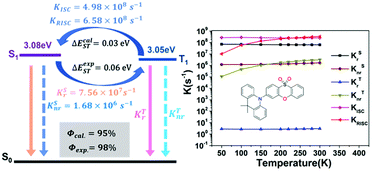Theoretically elucidating high photoluminescence performance of dimethylacridan-based blue-color thermally activated delayed fluorescent materials†
Abstract
Organic donor–acceptor (D–A) type thermally activated delayed fluorescence (TADF) materials exhibit high luminous quantum efficiencies and therefore attract considerable research interest as organic light-emitting diodes (OLEDs). Accurately calculating the photoluminescence efficiency is crucial for the design of new TADF materials. In this work, we comprehensively quantify the luminous quantum efficiencies and related photophysical process rates of dimethylacridan-based blue-color TADF emitters (AC-OSO and ACRXTN), and demonstrate that the higher reverse intersystem crossing rates (e.g. KRISC = 4.98 × 108 s−1) from T1 to S1 and the suppressed non-radiative decay rates (e.g. KSnr = 1.68 × 106 s−1) together lead to a theoretical luminous quantum efficiency of around 100%. Our calculations predict well fluorescence efficiencies observed in experiments (Φcal = 95%). In both molecules, the nonradiative rates of S1–S0 and reverse intersystem crossing rates are affected by the reorganization energies due to the twisting vibration of the donor DMAC and acceptor moiety. Our theoretical study on the TADF mechanism will be beneficial for designing highly efficient TADF based OLED materials.



 Please wait while we load your content...
Please wait while we load your content...